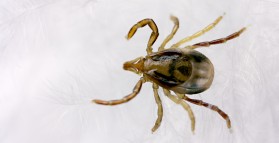Paralysis Ticks
Posted on Monday 10th December 2012

They may be small, but they're prolific. The female paralysis tick is capable of laying up to 3,000 eggs. After hatching, the larvae climb onto nearby vegetation and look for their first hosts. Once they have engorged the required amount of blood, the larvae drop to the ground, moult and turn into nymphs. Each nymph will then attach itself to a second host, once again fill on blood, drop off the host, and moult to become an adult tick. The adult ticks will attach to their third host and after getting a fill of blood the female paralysis ticks are ready to abandon their final host and lay their eggs. Bandicoots, possums and other native animals are common hosts, they unlike our pets are usually immune to the effects of paralysis ticks.
Tick poisoning in animals (especially pets) tends to peak in spring through to mid-summer. However, it is imperative that you stay vigilant all year as paralysis ticks are still prevalent during the cooler months.
There are a number of preventative measures available to kill ticks or prevent them from attaching to your pet. These range from collars and tablets, to spot-on applications and washes. These products offer varying protection. Your Veterinarian can help you select a product that would most suit your needs.
Whichever product you use, it is still essential to check your pets for ticks daily by running your finger tips throughout your pet’s coat down to skin level, feeling and looking. Daily checks could save your pet’s life, if the tick is found and removed before serious toxicity occurs.
Some symptoms of tick paralysis include;
- Change of voice (Bark/Meow)
- Coughing.
- Difficulty swallowing.
- Loss of appetite
- Noisy panting.
- Vomiting or dry retching, excessive salivation, difficulty swallowing, difficulty breathing, coughing.
As symptoms progress you may notice;
- Coma.
- Incontinence.
- Laboured breathing.
- Limb weakness, starting in the hind legs, progressing to the front legs, appearing wobbly & uncoordinated, falling over, paralysis.
If your pet has been poisoned by a tick it is important to try to keep yourself & your pet as calm as possible. Remove food & water as poisoning can prevent the pet from swallowing properly, which in turn could lead to choking. Take it to a veterinarian as soon as possible. The longer you delay taking your pet to a vet, the worse the symptoms will become and eventually it may lead to death.

